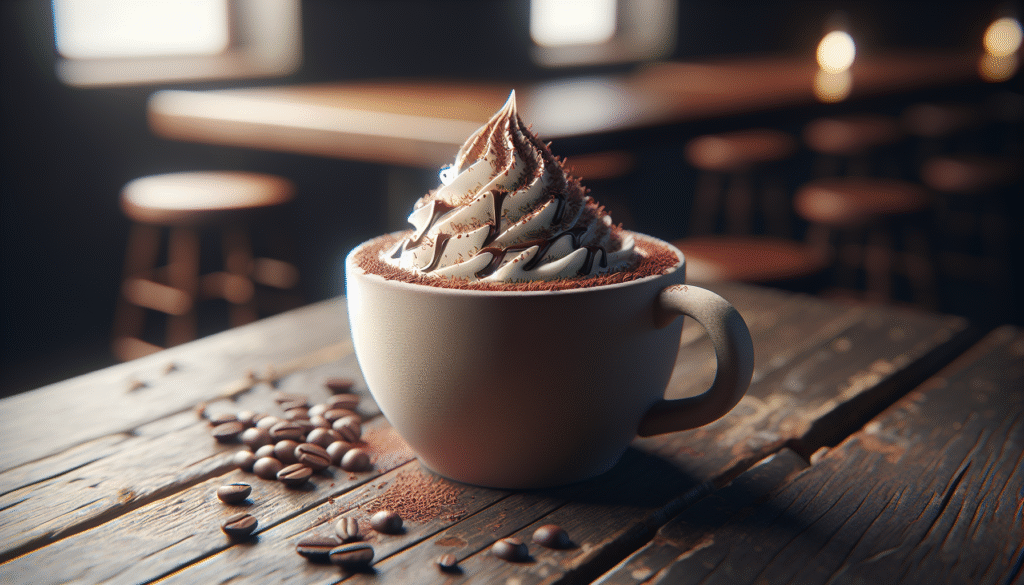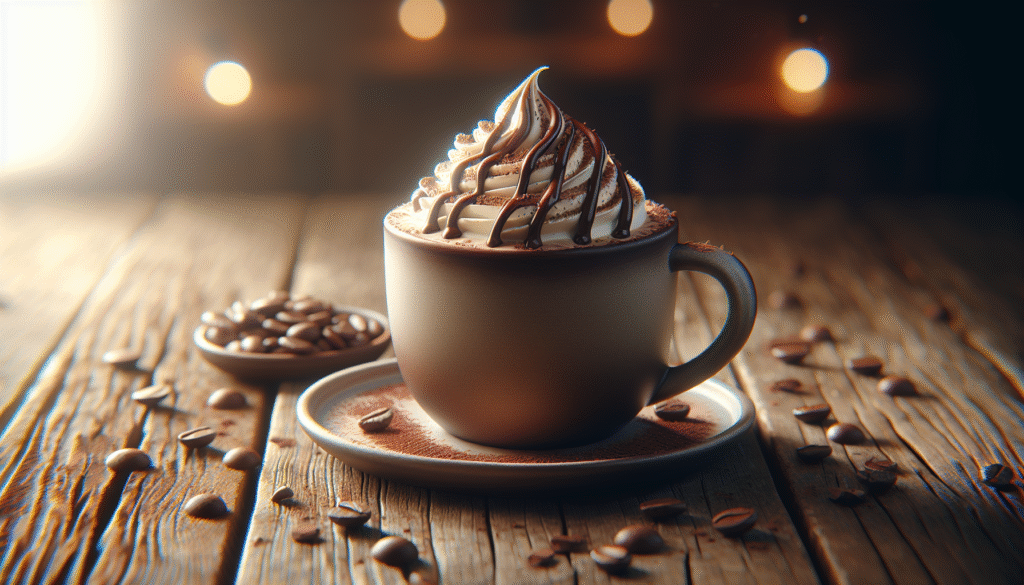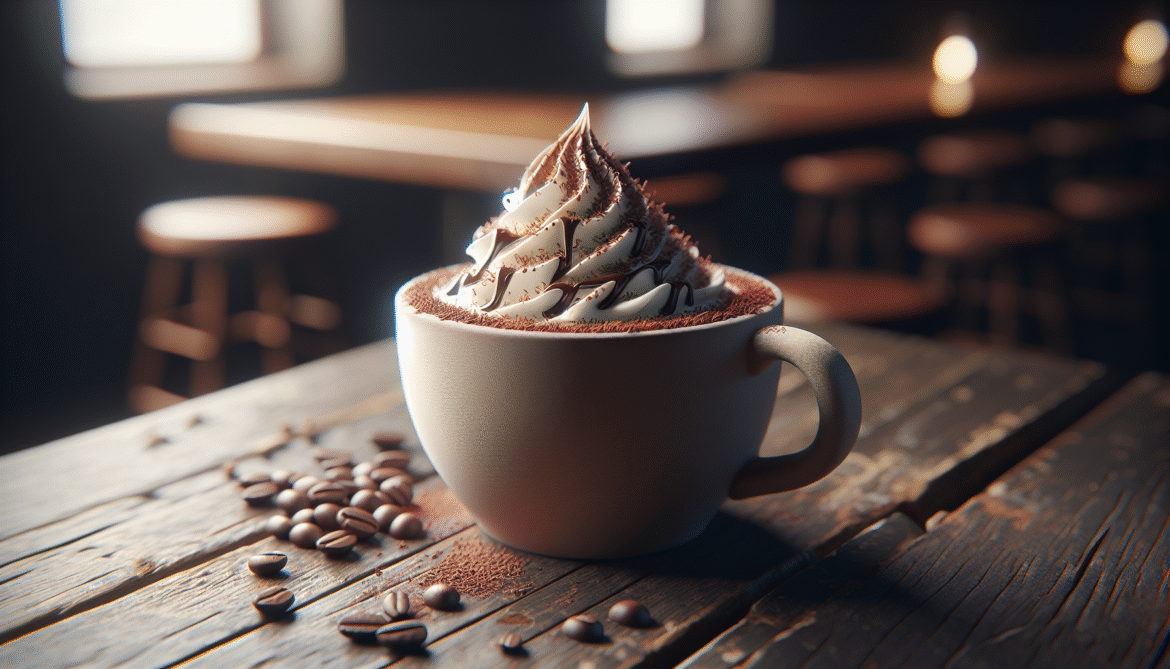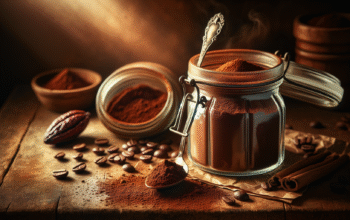Have you ever wondered what makes a Starbucks mocha taste like a comforting hug in a cup?

Starbucks Mocha Indulgence
You’re about to get a full look at what goes into the Starbucks mocha experience, how it differs from other espresso drinks, and how you can order, customize, or make your own version at home. This article walks you through history, ingredients, nutrition, menu variations, customization hacks, and barista tips so you can appreciate every sip and shape the perfect mocha for your taste.
What Is a Mocha?
A mocha is a coffee-based beverage that marries espresso and chocolate, usually combined with steamed milk and often finished with whipped cream. You’ll find versions that range from a simple espresso shot with chocolate to elaborate blended drinks with flavored syrups and toppings.
Mocha blends the bitter, roasted character of espresso with sweet, sometimes bitter, cocoa notes. The result is a layered drink that can be adjusted to highlight coffee, chocolate, or creaminess, depending on how it’s prepared.
The Origins of “Mocha”
The term “mocha” traces back to the port city of Mocha (al-Makha) in Yemen, which was historically a key export point for coffee. Early coffee trade linked Yemen to chocolate-containing drinks, and over time, “mocha” became associated with coffee that carries chocolate flavors.
You’ll find that the name now refers more to the flavor combination than to any specific origin of beans. Modern mochas are a global product, combining coffee and chocolate traditions from multiple places.
Mocha vs. Other Espresso Drinks
A mocha shares elements with lattes and hot chocolate but is distinct in its chocolate-espresso balance. While a latte emphasizes steamed milk and espresso, a mocha adds chocolate as a defining ingredient. Compared to hot chocolate, a mocha contains a shot or more of espresso, giving it a pronounced coffee backbone.
Below is a concise comparison to help you see these differences at a glance.
| Drink | Main Components | Typical Flavor Focus |
|---|---|---|
| Mocha (Caffè Mocha) | Espresso + chocolate syrup or cocoa + steamed milk | Balanced coffee and chocolate |
| Latte | Espresso + large steamed milk | Milk-forward, subtle espresso |
| Cappuccino | Espresso + equal parts steamed milk and foam | Strong espresso with light foam |
| Hot Chocolate | Cocoa + milk, no espresso | Pure chocolate sweetness |
You can use this table to choose the right drink depending on whether you want coffee prominence, chocolate prominence, or a balanced blend.
The Starbucks Mocha Experience
Starbucks applies its signature approach to mochas by using consistent recipes, quality-controlled espresso, and a range of chocolate bases and seasonal twists. You’ll notice mochas on the menu in classic, white chocolate, and seasonal variations that layer different flavor syrups and toppings.
Starbucks mochas are designed to be approachable and customizable, letting you amplify or tone down sweetness, swap milks, and select toppings. This makes them a great canvas for personal preferences.
Classic Caffè Mocha
When you order a Caffè Mocha at Starbucks, you typically get shots of espresso combined with mocha sauce and steamed milk, finished with whipped cream. The mocha sauce provides a sweet chocolate profile that complements Starbucks’ espresso roast.
You’ll find that the classic version is rich and slightly sweet, making it a favorite for those who want chocolate without losing the coffee note.
White Chocolate Mocha and Other Variations
The White Chocolate Mocha swaps out traditional mocha sauce for a sweeter, creamier white chocolate sauce. This gives the drink a richer, dessert-like quality and a smoother cocoa profile without dark cocoa bitterness.
Beyond white chocolate, Starbucks offers variations like mocha with flavored syrups (peppermint, caramel, hazelnut), seasonal limited-time combos, and iced or blended versions. Each variant shifts the flavor balance and sweetness level.
| Starbucks Mocha Variant | Typical Ingredients | Typical Occasion |
|---|---|---|
| Caffè Mocha | Espresso, mocha sauce, steamed milk, whipped cream | Everyday classic |
| White Chocolate Mocha | Espresso, white chocolate sauce, steamed milk, whipped cream | Sweeter preference |
| Peppermint Mocha | Espresso, mocha + peppermint syrup, steamed milk, whipped cream | Holiday season |
| Salted Caramel Mocha | Espresso, mocha + caramel, sea salt drizzle, whipped cream | Sweet-salty pairing |
| Iced Mocha | Espresso or cold brew + mocha sauce, milk, ice | Warm weather or cold preference |
| Mocha Frappuccino | Coffee or crème base blended with mocha, topped with whipped cream | Cold, dessert-like treat |
This table gives you a snapshot of common Starbucks mocha options and when you might choose each one.
Ingredients and Flavor Components
To appreciate or recreate a mocha, you should know the role each component plays. Espresso delivers intensity and complexity, chocolate contributes sweetness and cocoa notes, milk provides creaminess, and toppings add texture and visual appeal.
Balancing these elements is the key to a well-rounded mocha. Too much chocolate can mask the espresso; too little can make the drink feel more like a caffeinated latte.
Espresso: The Foundation of Flavor
Espresso is the concentrated coffee brew that serves as the backbone of the mocha. The roast and extraction influence bitterness, acidity, and body, which interact with the chocolate to produce the final flavor.
You’ll find that Starbucks uses its house espresso roast for many espresso-based drinks, giving mochas a consistent, slightly bold coffee character that stands up to chocolate’s sweetness.
Chocolate: Syrup vs. Cocoa
Chocolate in mochas usually comes in two forms: a pre-made chocolate syrup (often called mocha sauce) or a cocoa-based powder. Syrups are sweet and smooth, providing consistent texture, while cocoa powders can offer a more bitter, complex chocolate note.
If you want a darker, less sweet mocha, a higher proportion of unsweetened cocoa or a darker chocolate syrup will lean that way. If you prefer a sweeter and creamier profile, white chocolate or sweet mocha sauces will do the trick.
Milk and Foam
Milk is the mouthfeel agent in a mocha, smoothing the edges of espresso and integrating chocolate evenly through the drink. Whole milk gives you the richest texture, while lower-fat or plant-based milks change body and flavor.
You’ll notice that oat and almond milks create different foam behaviors and slightly different tastes. Baristas adjust steaming techniques to get the right microfoam for texture without scalding the milk.
Toppings and Add-ons
Whipped cream, chocolate drizzle, cocoa powder, and flavored drizzles transform a mocha from a simple drink to a sensory treat. These toppings can add creaminess, texture, and visual appeal.
Use toppings to make a drink more indulgent, but be aware they add calories and sweetness. For a cleaner flavor, skip the whipped cream and request a simple drizzle or dusting.
| Add-on | Flavor/Texture Impact | Typical Calorie Impact |
|---|---|---|
| Whipped cream | Adds creaminess, mouthfeel, sweetness | +70–120 kcal per serving |
| Chocolate drizzle | Intensifies chocolate | +20–60 kcal |
| Cocoa or cinnamon dusting | Aroma and slight bitterness | +5–15 kcal |
| Caramel drizzle | Sweet, sticky finish, salty-sweet combos | +40–80 kcal |
This table helps you decide which add-ons are worth the extra calories for the flavor you want.
Nutritional Information and Calories
Mocha drinks can range from moderately caloric to quite high, depending on size, milk choice, and toppings. Knowing approximate calories and macronutrients helps you make mindful choices when ordering.
Below is an approximate nutritional snapshot for Starbucks’ classic Caffè Mocha prepared with whole milk and whipped cream. Values will change with milk swaps, sugar-free syrups, or the removal of whipped cream.
| Size | Approx. Calories | Total Fat (g) | Sugars (g) | Espresso Shots |
|---|---|---|---|---|
| Tall (12 oz) | 320–350 kcal | 14–16 g | 30–36 g | 1–2 shots |
| Grande (16 oz) | 400–450 kcal | 16–20 g | 45–50 g | 2 shots |
| Venti Hot (20 oz) | 470–520 kcal | 21–26 g | 55–60 g | 2–3 shots |
| Venti Iced (24 oz) | 430–470 kcal | 16–20 g | 50–55 g | 3 shots |
These numbers are estimates to help you plan. If you want exact figures for your location, ask your barista for ingredient and nutrition information or check Starbucks’ official nutrition guides, which account for regional recipe variations.
Caffeine Content
Caffeine depends on the number of espresso shots and whether the drink is hot or iced (which may use extra shots). As a guide:
- A single espresso shot: ~70–75 mg of caffeine (varies with roast and extraction).
- Grande Caffè Mocha typically contains two shots: ~140–150 mg.
- Venti Iced or beverages with extra shots can reach 200+ mg depending on additions.
If you’re caffeine-sensitive, ask for one shot, decaf, or a half-caf option.
Customizing Your Mocha
You have many ways to make a mocha match your taste or dietary needs. You can reduce sugar, choose different milks, request stronger espresso, or add flavored syrups.
Customizing also helps you manage calories or allergens while still enjoying the essence of a mocha.
Lower-Calorie Swaps
You can reduce calories without losing the mocha’s basic character by making a few strategic swaps:
- Choose nonfat milk or unsweetened plant milk to cut fat.
- Request no whipped cream to save about 70–120 calories.
- Use fewer pumps of mocha sauce or request sugar-free mocha if available.
- Order a smaller size or ask for “short” size when available.
These swaps preserve the chocolate-coffee balance while cutting excess calories.
Vegan and Dairy-Free Options
Starbucks offers oat, soy, almond, and coconut milks in many locations. To make your mocha dairy-free:
- Substitute dairy milk with oat or almond milk.
- Request no whipped cream or ask about dairy-free whipped toppings where available.
- Verify that the chocolate sauce is dairy-free; many chocolate sauces contain milk or milk derivatives, so ask your barista for ingredient details or select alternative syrups like mocha powder that may be dairy-free.
With these adjustments, you’ll still get a delicious mocha without dairy.

Making a Starbucks-style Mocha at Home
You can reproduce a similar mocha at home with the right ingredients and technique. The core elements are espresso (or strong brewed coffee), chocolate syrup or cocoa blend, milk, and a finishing topping if you like.
Following a reliable recipe will give you a consistent result. Below is a go-to recipe for a single serving that resembles Starbucks’ Caffè Mocha.
Homemade Starbucks-style Caffè Mocha (Single Serving)
Ingredients:
- 2 shots of espresso (about 60 ml) or 1/2 cup of very strong brewed coffee
- 2 tablespoons chocolate syrup (adjust to taste) or 1 tablespoon unsweetened cocoa + 1–1.5 tbsp sugar
- 8–10 oz milk of choice (whole milk for richness; oat or almond for dairy-free)
- Whipped cream and chocolate drizzle (optional)
Instructions:
- Brew your espresso or strong coffee. If using an espresso machine, pull two shots. If using a Moka pot or Aeropress, follow your device’s instructions for a concentrated brew.
- Add the chocolate syrup to your warmed mug. If using cocoa + sugar, mix to form a smooth paste with a splash of hot water or espresso.
- Pour the hot espresso over the chocolate and stir until fully combined.
- Steam or heat the milk until warm and frothy. If you don’t have a steamer, heat the milk gently on the stove or microwave and shake in a jar to create foam.
- Pour milk into the espresso-chocolate mixture, holding back foam with a spoon and then spooning foam on top.
- Top with whipped cream and a drizzle of chocolate if desired.
This recipe gives you a classic hot mocha. For an iced version, combine espresso, chocolate, and milk over ice and stir vigorously. For a blended Frappuccino-style mocha, blend the components with ice and a bit of milk until smooth.
Ingredient Substitutions and Tips
| Ingredient | Substitute | Effect on Flavor/Texture |
|---|---|---|
| Whole milk | Oat milk | Creamy texture, slightly sweet, works well in mochas |
| Chocolate syrup | Unsweetened cocoa + sugar | Less sweet, more cocoa bitterness |
| Espresso shots | Strong brewed coffee | Less concentrated, milder mocha |
| Whipped cream | Coconut whipped cream | Dairy-free, similar texture |
Use this table to adapt your mocha to what you have and to dietary preferences. Small changes can produce a markedly different final result.
Seasonal and Limited Editions
Starbucks often releases seasonal mocha-based drinks, with peppermint mocha being the most iconic during winter holidays. Seasonal offerings combine classic mocha with seasonal flavorings, like peppermint, pumpkin spice accents, or special sauces.
These limited-time drinks let you try new flavor pairings without changing the coffee base drastically. They’re a great way to mix up your routine during certain times of the year.
Popular Seasonal Options
- Peppermint Mocha: mocha sauce plus peppermint syrup and whipped cream; usually offered in winter. It gives a mint-chocolate profile that’s festive and bright.
- Pumpkin Spice Mocha variations: less common than the pumpkin spice latte, but occasionally Starbucks introduces mocha-infused seasonal drinks with autumnal spices.
- Toasted White Chocolate Mocha: a richer, slightly caramelized white chocolate version often introduced as a holiday or winter option.
Trying seasonal mochas gives you a sense of how the chocolate element can be combined with other complementary flavors.
Pairing Your Mocha with Food
Mochas pair well with both sweet and savory items. Because they contain chocolate and milk, they work nicely alongside pastries, fruit, and certain savory items that can stand up to sweetness.
Here are a few pairings to consider when you want a satisfying snack with your mocha.
- Chocolate croissant or pain au chocolat: a chocolate-on-chocolate match that reinforces cocoa flavors.
- Blueberry muffin: fruity acidity balances the mocha’s sweetness.
- Almond croissant: nutty richness pairs nicely with chocolate and coffee.
- Egg sandwich or savory pastry: the coffee component helps cut through fat and enriches savory flavors.
Choose pairings based on whether you want complementary flavor reinforcement (e.g., chocolate with chocolate) or contrast (e.g., fruity or savory items that brighten the drink).
Ordering Tips and Barista Lingo
Knowing a few terms and customizations will help you get the mocha you want quickly. Asking for specific shot counts, milk types, and sauce amounts clarifies your preferences.
Use this quick guide when ordering at a counter or app:
- “Caffè Mocha, Grande, 2 shots, oat milk, no whipped cream” — precise and efficient.
- “White Chocolate Mocha, Tall, 1 pump less syrup” — lets you reduce sweetness while keeping the major profile.
- “Iced mocha with extra ice, light syrup” — indicates an iced drink with a lower syrup amount.
Baristas appreciate clear, concise requests. If you’re unsure about an ingredient, asking “What’s in this?” helps you avoid allergens or unwanted additions.
Common Customization Shortcuts
| Term to Request | What It Means |
|---|---|
| “Light syrup” | Fewer pumps than standard |
| “No whip” | No whipped cream |
| “Add an extra shot” | One more espresso shot than standard |
| “Half-caf” | Half of the espresso is decaffeinated |
| “Sub oat milk” | Replace dairy milk with oat milk |
Using these shortcuts will make ordering faster and ensure you get your mocha made the way you like it.
Barista Tips if You Make It Yourself
If you’re preparing mochas at home, small techniques make a big difference. Quality of espresso, milk temperature, and how you combine the chocolate with espresso determine the finished drink’s smoothness and flavor balance.
Consistent technique leads to repeatable results.
- Heat milk to about 140–150°F (60–65°C) for optimal sweetness and texture without scalding.
- Mix chocolate syrup with a bit of hot espresso first to create a uniform chocolate base.
- If frothing with a handheld frother, aim for fine microfoam by keeping the tip just under the surface until you get a velvety texture.
- Clean your equipment regularly; old milk residue and chocolate buildup affect flavor.
These tips will help you create café-quality mochas in your own kitchen.
Sustainability and Sourcing
You may care about where your coffee and chocolate come from. Starbucks has public programs and commitments aimed at more responsible sourcing for coffee, and some transparency on cocoa sourcing for their chocolate-based products.
When you order or buy Starbucks products, you can ask or check online for the latest information on sourcing practices, certifications, and sustainability initiatives in your region. Supporting responsible sourcing can help promote better conditions for farmers and more sustainable practices overall.
Frequently Asked Questions
Q: Is a mocha the same as a hot chocolate with espresso?
A: Not exactly. A mocha blends chocolate and espresso in a way that highlights both. Hot chocolate typically lacks espresso and focuses entirely on cocoa and milk. Mochas aim for a balanced interplay of coffee and chocolate.
Q: Can you make a mocha without espresso?
A: Yes. You can use very strong brewed coffee, a Moka pot brew, or concentrated cold brew to achieve a similar profile. It won’t be identical to espresso, but it will still give you a chocolate-coffee beverage.
Q: How can I make my mocha less sweet?
A: Request fewer pumps of mocha sauce, choose unsweetened cocoa blends, or request a smaller size. Swapping to a less sweet milk option and omitting whipped cream also helps.
Q: Are Starbucks mocha sauces dairy-free?
A: Some chocolate sauces may contain dairy or butter derivatives. If you need a dairy-free option, ask the barista for current ingredient details or select dairy-free syrups and milk.
Q: What’s the best milk for a creamy mocha?
A: Whole milk gives the creamiest result; oat milk is the best plant-based substitute for creaminess and a neutral flavor. Almond and soy each have distinct flavor notes that may alter the mocha profile.
Final Thoughts
You’re now equipped to understand, order, customize, or create a Starbucks-style mocha that fits your taste and lifestyle. Whether you prefer a classic Caffè Mocha, a white chocolate version, or a seasonal peppermint twist, the building blocks are the same: espresso, chocolate, milk, and thoughtful customization.
Try a few variations to discover how small changes in chocolate type, milk, or espresso shots shift the balance between coffee and chocolate. With this knowledge, you’ll get more satisfaction from each sip and more confidence when ordering or making your own mocha.



